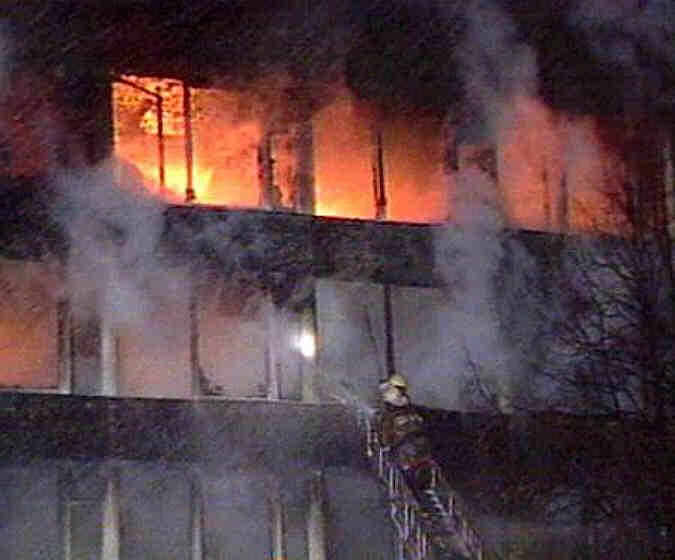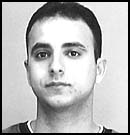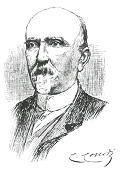 2003
Nfumu-Ngui “Floquet de Neu”, 40, killed for suffering
from skin cancer since 2001, at the Barcelona zoo, where he was imprisoned
since the age of 3, after have been captured in his native Equatorial Guinea.
He was the world's only know albino gorilla. Nfumu was affected by an oculocutaneous
albinism that could be equivalent to Type I-B or yellow albinism in human
beings. This seems to be associated with reduced but sufficient levels of
residual tyorinase activity to produce small amounts of pigment. His skin
was totally white and the membranes were pale pink. hairs were also white
although in some areas (head and shoulders) they were light cream yellow.
Iris was blue to gray and small amounts of pigment were found in the iridial
stroma and in the retina. Pigment was absent in the posterior epithelium
and the iris was fully translucent on globe transllumination. Nfumu means
“white” in the fang language of those who captured him when
he was 2, after killing his mother and all his relatives. The Barcelona
zoo in vain tried to breed him to produce more albino gorillas. He had 22
children, but all were dark gorillas apparently normal, though all the males
were sterile. The zoo even tried to breed him to his own daughters, but
Nfumu's standards of morality were higher than those of his jailers, and
he always refused to commit incest. Because of his albinism, Nfumu squinted
a lot in the bright sunlight and often people mistakenly thought that he
was grimacing or angry. [photo >]
2003
Nfumu-Ngui “Floquet de Neu”, 40, killed for suffering
from skin cancer since 2001, at the Barcelona zoo, where he was imprisoned
since the age of 3, after have been captured in his native Equatorial Guinea.
He was the world's only know albino gorilla. Nfumu was affected by an oculocutaneous
albinism that could be equivalent to Type I-B or yellow albinism in human
beings. This seems to be associated with reduced but sufficient levels of
residual tyorinase activity to produce small amounts of pigment. His skin
was totally white and the membranes were pale pink. hairs were also white
although in some areas (head and shoulders) they were light cream yellow.
Iris was blue to gray and small amounts of pigment were found in the iridial
stroma and in the retina. Pigment was absent in the posterior epithelium
and the iris was fully translucent on globe transllumination. Nfumu means
“white” in the fang language of those who captured him when
he was 2, after killing his mother and all his relatives. The Barcelona
zoo in vain tried to breed him to produce more albino gorillas. He had 22
children, but all were dark gorillas apparently normal, though all the males
were sterile. The zoo even tried to breed him to his own daughters, but
Nfumu's standards of morality were higher than those of his jailers, and
he always refused to commit incest. Because of his albinism, Nfumu squinted
a lot in the bright sunlight and often people mistakenly thought that he
was grimacing or angry. [photo >]
2003:: 33 students, in fire [< photo] which starts at 02:00 due to a short-circuit in room 203 on the 2nd floor of a filthy 5-story dormitory of Patrice Lumumba People's Frienship University in Moscow, which housed, 3 instead of the designed 2 to a room, 272 students newly arrived from Vietnam, Ecuador, Tahiti, Afghanistan, Tajikistan, Angola, and mostly China, who were awaiting medical check-ups. At least 3 of the deaths and many of the injuries to some 170 persons, were caused by jumping from the upper floors, as one of the two stairwells was blocked, besides the second floor being engulfed in flames. It is 05:30 by the time firefighters put out the fire.
2002 At least 5 worshippers and one policeman, during a 19:00 to 19:30 gun battle between Indian security forces and independentist guerillas who storm the 150-year-old Raghunath temple complex in the city of Jammu, in Indian-occupied Kashmir.
2002 John Rawls, of heart failure, incapacitated since a 1995 stroke. Born on 21 February 1921 he was a US political theorist whose A Theory of Justice (1971) insisted that a society ought not to seek the greatest good of the greatest number of people at the expense of the rights of minorities.
2001: 24 persons aboard Crossair Flight LX3597 from Berlin which crashes just after 22:00 as it approaches Zurich Airport to land, with rain and some snow. On board are 28 passengers and five crew members. The plane goes down in a wooded area in Birchwil, some 3 km east of the airport and its middle section is engulfed in a fireball. The plane is a Jumbolino (= Avro RJ), manufactured by Britain's BAE Aircraft Services Group, a small, four-engine jetliner that can seat 97 passengers.
2000 Ghassan Karaan, 20, and Ayfar Hasis, 15, Palestinians killed by Israeli gunfire in rock-throwing clashes in the West Bank towns of Qalqilya and Jenin.
2000 Ziad Abu Jeser, 20, shot more than a dozen times by Israelis, in the Gaza town of Rafah.
 2000
Ariel Jeraffi, 40, Israeli of Petah Tikva, the father of three,
killed by Palestinian fire as he traveled near Otzarin. Jeraffi, a civilian
employed by the IDF, had been carrying out construction work in the settlement
of Barkan. Four bullets penetrated the vehicle in which he was traveling,
one of them penetrating his flack jacket and piercing his abdomen. The Israeli
army imposed a curfew on Otzarin. This brings the total of dead from the
al-Aqsa intifadah to 271, at least 85% of whom are Palestinians.
2000
Ariel Jeraffi, 40, Israeli of Petah Tikva, the father of three,
killed by Palestinian fire as he traveled near Otzarin. Jeraffi, a civilian
employed by the IDF, had been carrying out construction work in the settlement
of Barkan. Four bullets penetrated the vehicle in which he was traveling,
one of them penetrating his flack jacket and piercing his abdomen. The Israeli
army imposed a curfew on Otzarin. This brings the total of dead from the
al-Aqsa intifadah to 271, at least 85% of whom are Palestinians.2000 Sami Amer, 32, and Naheed Amer, 26, Palestinian brothers killed by shrapnel from Israeli rocket in the West Bank village of Kufr Kalil, where they were leaders of Fatah.
2000 Sharon Arameh, 25, [photo >] of Ashkelon, Israeli army major, by Palestinian sniper fire in the afternoon, during fighting near the Gaza Strip settlement of Neveh Dekalim.
2000 Six persons, by armed militants who kidnapped them from a bus stop, in Akhala, India. The Lashkar-e-Tayyiba is probably responsible.
| 2000 Zhao Jing, 19, Falun Gong
woman, murdered by Chinese police. She was arrested the previous day on a train in the northern province of Hebei while traveling to Beijing with other Falun Gong followers. Her companions hear her cries as police beat her. Then the police throw her to her death out of an upper floor window. On 26 November 2001, police would notify her family that she died after falling in an escape attempt. This brings to at least 74 the death toll in China's 17-month crackdown on the Falun Gong. Wang Huachen, a 32-year-old chemical factory worker, died, on 18 November 2000, in a hospital of injuries he got jumping out of a fourth-story window at a police station in the northeastern city of Huludao. Wang jumped after police beat him for two hours with wooden poles on 07 November 2000, the day they arrested him for refusing to leave Falun Gong. Chinese officials have declined to discuss individual reports of police abuse but deny that any followers have died from mistreatment. At least 74 Falun Gong followers are known to have died in detention since China banned the group in July 1999, but Falun Gong says that the number is much higher. Falun Gong attracted millions of members in the 1990s with its health exercises and eclectic mix of Taoism, Buddhism and the ideas of its founder, former government clerk Li Hongzhi, now a refugee in the United States. China outlawed Falun Gong calling it an evil cult that caused the death of at least 1500 followers. Communist Party leaders apparently fear the group's size and organization could challenge their monopoly on power. |
| 1973 John Neihardt, 92, ghostwriter
of Black Elk Speaks John Neihardt was the ghostwriter of one of the most popular and enduring chronicles of traditional Native American culture, Black Elk Speaks. Neihardt was raised on the plains of Kansas and Nebraska. One of his first jobs after graduating from college was as an assistant agent on the Omaha Indian reservation in Nebraska. During his six years on the reservation, Neihardt studied the history and customs of the Omaha and decided to chronicle the story of western expansion. His first important works were epic poems celebrating the heroic achievements of western fur traders and explorers. The poems have largely been forgotten, though at the time they won Neihardt a measure of success. Neihardt did not write his most famous work until he was in his 50s. In the early 1930s, he met an Oglala Sioux holy man named Black Elk (Hehaka Sapa) and began to write his autobiography for publication. Black Elk, who was in his 60s, had witnessed many of the major historical events of his people during the latter 19th century. As a young teenager, he had fought at the Battle of the Little Bighorn in 1876 and lived to witness the final brutal suppression of the Sioux at the Wounded Knee Massacre of 1890. Since experiencing a powerful mystic vision at the age of nine, Black Elk had also been a Sioux holy man. He believed his people's many trials were a result of their increasing materialism and failure to remain in close communion with the natural world. The collaboration between Neihardt and Black Elk produced a moving book that offered a rare window into the history and beliefs of a disappearing culture. A perennial favorite among high school and college students learning Native American history, Black Elk Speaks also became popular among Indians interested in reconnecting with their cultural roots. It is credited with creating a "renaissance of Lakota spirituality." |
| 1971 Dan Cooper, while or after
parachuting from a plane he had hijacked A hijacker who identified himself as Dan B. Cooper parachutes from a Northwest Airlines 727 over Washington State with $200'000 in ransom into a raging thunderstorm. Cooper commandeered the aircraft shortly after takeoff, showing a flight attendant something that looked like a bomb and informing the crew that he wanted $200'000, several parachutes, and "no funny stuff." The plane landed at Seattle-Tacoma International Airport, where authorities met Cooper's demands and evacuated most of the passengers. Cooper then ordered the plane to fly toward Mexico via Reno, Nevada, at a low altitude, and ordered the remaining crew into the cockpit. At 20:13, as the plane flew over the Lewis River in southwest Washington, the plane's pressure gauge recorded Cooper's jump from the aircraft. Wearing only wrap-around sunglasses, a thin suit, and a raincoat, Cooper parachuted into a raging thunderstorm with, at the 3000-meter altitude where he began his fall, winds in excess of 250 km/h and temperatures below zero. The storm prevented an immediate capture, and many authorities assumed he was killed during his suicidal parachute jump. No trace of Cooper was found during a massive search that continued for eighteen days, however, in 1980 an eight-year-old boy uncovered a stack of nearly $6000 of the ransom money in the sand along the Columbia River, eight kilometers from Vancouver, Washington. |
1964 Paul Carlson, Christian doctor in the Congo, killed minutes before Belgian paratroops land to attempt rescue of the hostages held by Simba rebels.
1963 Lee Harvey Oswald, 24, alleged assassin of President John F. Kennedy, is shot to death by Jack Ruby, a Dallas nightclub owner, at 11:21 in the basement of the Dallas police station, on live TV. — MORE.
 1962
James J. Kilroy, 60, riveting inspector. 1962
James J. Kilroy, 60, riveting inspector.James J. Kilroy lived in Boston, Massachusetts, served in the Legislature and during World War II worked as a shipyard inspector at the Fore River Shipyard in Quincy, MA. That is where the famous saying was born. Kilroy checked and recorded the number of rivets that were driven by workers who got paid by the number of rivets placed. At first, Kilroy would count a block of rivets and use a chalk check mark to indicate that block had been checked so the the rivets wouldn't be counted twice. However some riveters would erase the chalk mark when Kilroy went off duty so that when a new checker came along it would get counted twice and the riveters would get paid twice. Kilroy's boss noticed that riveters were getting paid a lot and wanted Kilroy to find out what was going on. Once Kilroy discovered what the riveters were doing, along with his chalk check mark he would put in large crayoned letters, "Kilroy Was Here". The riveters from then on quit wiping out his chalk marks. Before a ship shipped out it was normally painted covering up the chalk marks and Kilroy's inspection slogan. Ships were being built and sent out so fast that there wasn't time to paint them. Millions of service men saw the slogan on the outgoing ships and all they knew was that "Kilroy" had been there first. Service men began placing the graffiti wherever the US Forces landed, claiming it was already there when they arrived. Kilroy then became the "Super-GI" who had always already been wherever the GI's went. The sketch of a man peeking over a fence was added somewhere along the way by a service man. In foreign lands, the slogan was often used as a code. It became a challenge to place the logo in the most unlikely places imaginable. It is said to be atop Mt. Everest, the Statue of Liberty, the underside of the Arc de Triomphe, and scrawled in the dust on the moon. An outhouse was built for the exclusive use of Roosevelt, Stalin, and Churchill for the Potsdam Conference. The first person inside was Stalin, who emerged and asked his aid , "Who is Kilroy?" WWII Recon Units sneaked ashore on Japanese held islands in the Pacific to map the terrain for the coming invasion by US troops (and thus, presumably, were the first GIs there): on one occasion, they reported seeing enemy troops painting over the logo, which had been placed there before the arrival of the US scout team. The tradition has continued throughout every US military operation following WWII. After the war, in 1946 the Transit Company of America held a contest offering a prize of a real trolley car to the person who could prove himself to be the "real" Kilroy. Almost 40 men stepped forward to make that claim, but James Kilroy brought along officials from the shipyard and some of the riveters to help prove his authenticity. James Kilroy won the prize of the trolley car which he gave to his nine children as a Christmas gift to be set up in their front yard for a playhouse. |
1939 Some 120 students in Czechoslovakia, executed by the Gestapo for alleged anti-Nazi plotting.
1928 Gyula Tornai, Hungarian artist born on 12 April 1861.
| 1922 Robert Erskine Childers,
Irish author and nationalist, by an Irish firing squad. a popular Irish author and member of the Irish Volunteers, a prototype of the Irish Republican Army (IRA), is shot to death by an Irish Free State firing squad after being convicted of carrying a small pistol. He had been one of the leaders, along with Eamon de Valera, of the Irish Republican rebellion against British and Irish forces who had agreed to the 1921 partition of Ireland. Childers, born in London, England, fought for Britain in the Boer War in South Africa, before writing The Riddle of the Sands in 1903, a popular novel involving an imaginary German raid on England that is considered one of literature's first spy stories. Childers became an advocate of Irish home rule and he and his wife used their sailboat to smuggle arms that were used by the Irish rebels during the Easter Uprising of 1916. During World War I, Childers served England as a volunteer in the Royal Navy and received a Distinguished Service Cross for his bravery. After the war, Childers traveled to Ireland where he fought in the Irish Civil War following partition of the island in 1921. After a year of leading Irish Volunteer forces, Childers was captured and executed. His son, Erskine Hamilton Childers, became the fourth president of the Irish Republic (1973-74), the second Protestant to hold the office. (The Riddle of the Sands at another site.) |
1750 Frans Breydel, Flemish artist born on 08 September 1679.
1693 Nicolaas Maes (or Maas), Dutch painter specialized in portraits, born in 1634 — MORE ON MAES AT ART “4” NOVEMBER with links to images.
1682 Picard Jean Michel Picart (or Picard), Flemish artist born in 1600.
1572 John Knox Scottish preacher. KNOX ONLINE: The First Blast of the Trumpet Against the Monstrous Regiment of Women , The Order of Excommunication and of Public Repentance
0029 Jesus of Nazareth (?) if marked by the total solar eclipse of 1m58s at 09:35 UT, visible in Judaea at about 12:00 local solar time.

 Carlo Lorenzini nacque a Firenze. Dopo aver lavorato presso una biblioteca,
nel 1848 Collodi partecipò alla seconda guerra d'indipendenza con
l'esercito piemontese. In quei mesi inaugurò la rivista satirica Il
Lampione, censurata nel 1849 per motivi politici ma poi ripresa
nel 1850: qui si firmò per la prima volta con lo pseudonimo di Collodi,
il paese vicino a Pistoia in cui era nata la madre. Nel 1853 fondò
La Scaramuccia e continuò a lavorare come giornalista fino
al 1859, quando si unì all'esercito di Giuseppe Garibaldi.
Carlo Lorenzini nacque a Firenze. Dopo aver lavorato presso una biblioteca,
nel 1848 Collodi partecipò alla seconda guerra d'indipendenza con
l'esercito piemontese. In quei mesi inaugurò la rivista satirica Il
Lampione, censurata nel 1849 per motivi politici ma poi ripresa
nel 1850: qui si firmò per la prima volta con lo pseudonimo di Collodi,
il paese vicino a Pistoia in cui era nata la madre. Nel 1853 fondò
La Scaramuccia e continuò a lavorare come giornalista fino
al 1859, quando si unì all'esercito di Giuseppe Garibaldi.